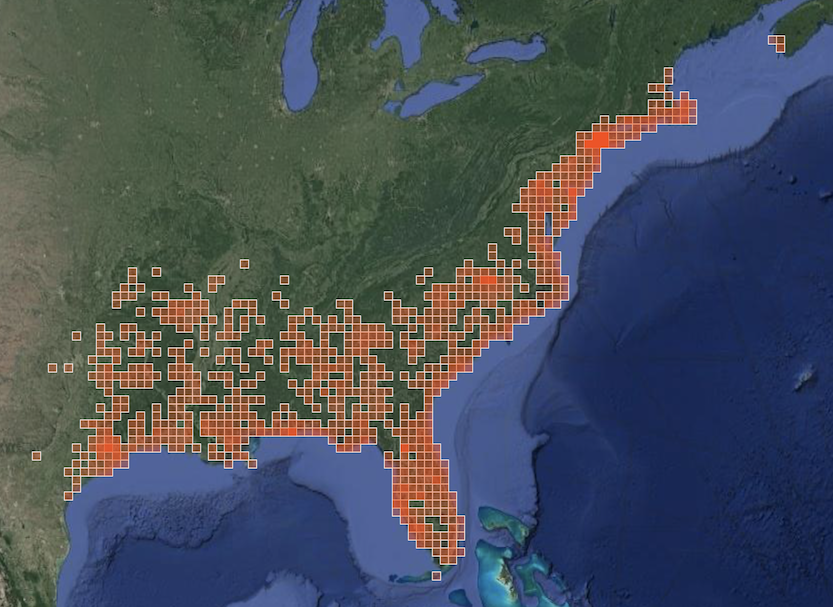Baccharis halimifolia (groundsel bush)
There are five species of microlepidoptera on the East Coast that are known to feed only on Baccharis halimifolia L. (Asteraceae): Bucculatrix ivella (Bucculatricidae), Aristotelia ivae (Gelechiidae), Epiblema discretivana (Tortricidae), Lorita baccharivora (Tortricidae), and Hellinsia balanotes (Pterophoridae). All five of these species occur on Block Island, which is near the northern end of the host plant’s range. Additionally, Macaria varadaria and Eusarca fundaria (both Geometridae) are known (in the former case) and suspected (in the latter case, per George Smiley) to be specialists on Baccharis in the Southeast US, but neither appears to have been recorded in the Northeast.

Baccharis is a very large Neotropical genus of hundreds of species, only a few of which occur in the Eastern US. B. halimifolia is the northernmost representative of the genus, occurring throughout the Deep South and north along the coast to Cape Cod, with isolated populations along a stretch of the southwest coast of Nova Scotia. A few other Baccharis species occur in Florida and along the coast north to the Outer Banks, and a number of species occur in the Western US. Common names for B. halimifolia include eastern baccharis, groundsel bush, sea myrtle, and saltbush, though the plant is often called simply baccharis across most of its range, where it is the only native member of its genus. I will use the common name eastern baccharis in this article to distinguish the species from the North American congeners I will mention.

On Block Island, eastern baccharis occurs in salt marsh and dune habitats. In salt marshes, it may be confused with marsh elder (Iva frutescens L.) (Asteraceae), which typically occurs only in a narrow band just above the reach of spring tides. Three of the five moth species that specialize on eastern baccharis were described in the early 1900s from specimens reared from plants misidentified as marsh elder, and all three unfortunately have specific epithets derived from their supposed host plants: Bucculatrix ivella, Aristotelia ivae, and Phalonidia elderana (Kearfott, 1907), which is almost certainly a senior synonym of Lorita baccharivora. Diatloff and Palmer (1988) studied the host specificity of A. ivae and L. baccharivora to determine their suitability for release as biocontrols of eastern baccharis in Australia, where it is invasive. Both species were found to have high host fidelity, though marsh elder unfortunately was not one of the plants tested.

Bucculatrix ivella Busck, 1900 (Bucculatricidae) is a leafminer. The last instar exits the mine and feeds externally, I think for a day or two, leaving characteristic markings on leaves. The larvae probably pupate on the host plant or on lower plants; I once found a cocoon on a blade of grass below the host.
Aristotelia ivae Busck, 1900 (Gelechiidae) feeds externally in loose silken shelters. George Smiley described the feeding habit and evidence to me as follows: “They are upper surface feeders [that build] a large loose web with multiple silk paths to feeding sites… Most of the time they start at the tip and as they grow in size they extend their web down to lower/larger leaves but occasionally it appears one sets up further down. I suppose that may be a parental decision. When not feeding they hang out in the loose web and from a good angle are easier to spot” (pers. comm. 17 ix 2022). This is the only Baccharis specialist with a likely record from Nova Scotia, a photograph of an adult taken in 2020. The sighting is from some 25km away from the nearest known Baccharis populations but on the immediate coast, indicating there may be one or more new or previously unnoticed populations of the host in the area. While I am fairly confident of the identification, A. fungivorella adults are similar enough to those of A. ivae that I can’t be certain; records of larvae or a collected adult specimen would be needed to confirm this large range extension.
Epiblema discretivana (Heinrich, 1921) (Tortricidae)
Lorita baccharivora Pogue, 1988 (Tortricidae) is a seed feeder.
Hellinsia balanotes (Meyrick, 1908) (Pterophoridae) is a stem borer.
*Macaria varadaria (Walker, 1860) (Geometridae) is a surface feeder.
*Eusarca fundaria (Guenée, [1858]) (Geometridae) is a surface feeder.
Diatloff G. & W.A. Palmer, 1988. The host specificity and biology of Aristotelia ivae Busck (Gelechiidae) and Lorita baccharivora Pogue (Tortricidae), two microlepidoptera selected as biological control agents for Baccharis halimifolia (Asteraceae) in Australia. Proc. Entomol. Soc. Wash. 90(4): 458–461.
Mazerlle D. & Blaney S., 2010. COSEWIC Status Report on Eastern Baccharis Baccharis halimifolia in Canada prepared for Committee on the Status of Endangered Wildlife in Canada, 44 pp.